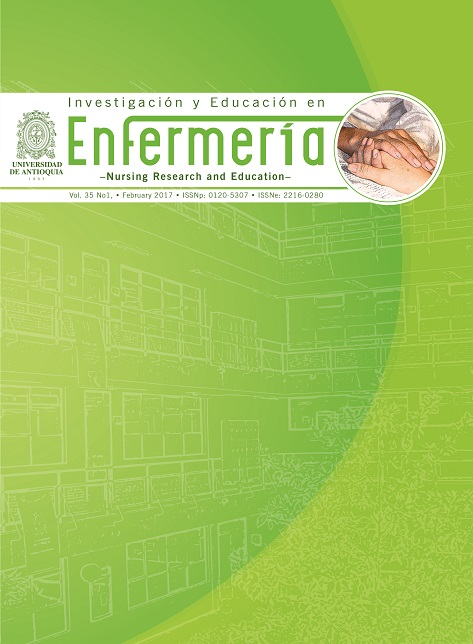Development of a measurement index of critical thinking in professional formation
DOI:
https://doi.org/10.17533/udea.iee.v35n1a08Keywords:
Thinking, educational evaluation, education, higher, scales.Abstract
Objective. This research sought to construct and validate a measurement index of critical thinking (CT) in professional formation.
Methods. Transversal, quantitative, test validation-type study. After reviewing scientific production in CT, which permitted defining the concept and its conceptual domains, a 65-item scale was constructed of closed questions on the analysis of cases evaluating CT. The scale was subjected to expert evaluation to then be applied to 53 undergraduate students (35 from nursing and 18 from sociology) to evaluate validity and reliability.
Results. The 65-item scale has an explained variance of 61.3% and is comprised of five CT domains: inference, evaluation, argumentation, analysis, and interpretation. A Cronbach’s alpha coefficient of 0.61 was obtained.
Conclusion. The scale proposed to assess students’ CT skills converges with concepts by known authors with the CT theory and is adequate for use as a CT measurement index in professional formation.
How to cite this article: Ospina BE, Brand EG, Aristizabal CA. Development of a measurement index of critical thinking in professional formation. Invest. Educ. Enferm. 2017; 35(1):
Downloads
References
(1) Butlera HA, Dwyerb CP, Hoganb MJ, Francoc A, Rivasd SF, Saizd C, et al. The Halpern Critical Thinking Assessment and real-world outcomes: Cross-national applications. Think. Skills Creat. 2012; 7:112–21.
(2) Pardamean B. Measuring Change in Critical Thinking Skills of Dental Students Educated in a PBL Curriculum. J. Dent. Educ. 2012; 76(4):443-53.
(3) Atay S, Karabacak U. Care plans using concept maps and their effects on the critical thinking dispositions of nursing students. Int. J. Nurs. Pract. 2012; 18:233–39.
(4) Valenzuela-González JR, Molina-Patlán C, MoralesMartínez GP, Competencia transversal pensamiento crítico: Su caracterización en estudiantes de una secundaria de México. Rev. Electron. Educare [Internet]. 2016 [cited 20 Jul 2016]; 20 (EneroAbril): Available from: http://www.redalyc.org/articulo.oa?id=194143011011
(5) Rivas SF, Sainz C. Validación y propiedades psicométricas de la prueba de pensamiento crítico PENCRISAL. Rev. Electron. Metod. Apl. 2012; 17(1):18-34.
(6) Black B. An overview of a programme of research to support the assessment of Critical Thinking. Think. Skills Creat. 2012; 7: 122–33.
(7) Facione PA. Critical thinking: what it is and why it counts [Internet]. Hermosa Beach, CA: Measured Reasons LLC; 2015 [Cited 20 Jun 2016]. Available from: www.insightassessment.com/pdf_files/what&why2006.pdf
(8) Facione NC, Facione EA, Sanchez C. A. Critical thinking disposition as a measure of competent clinical judgment: The development of the California Critical Thinking Disposition Inventory. J. Nurs. Educ. 1994; 33(8):345-50
(9) Watson G, Glaser EM. Watson- Glaser II, Critical Thinking appraisal [Internet]. Estados Unidos: Pearson; 2012 [Cited 20 Jun 2016]. Available from: https://www.talentlens.co.uk/assets/newsand-events/watson-glaser-user-guide-and-technicalmanual.pdf
(10) Paul R, Scriven, M. Defining critical thinking: A draft statement for the National Council for Excellence in Critical Thinking [Internet]. [Cited 21 Jun 2014]. Available from: http://www.criticalthinking.org/pages/defining-critical-thinking/410
(11) Ennis RH. Critical thinking assessment. Theory Pract. 1993; 32(3):179-86.
(12) Halpern DF. Thought and Knowledge: An Introduction to Critical Thinking (5th ed). New York: Psychology Press; 2014. p.637
(13) Paul R, Elder L. Critical thinking: concepts and tools. Santa Rosa, CA: The Foundation for Critical Thinking Press; 2009. p. 2–23.
(14) Facione PA, Facione NC, Blohm SW, Giancarlo C.A. The California Critical Thinking Skills Test: Test Manual. CA: California Academic Press, Milbrae. 2002
(15) Halpern, DF. The Halpern critical thinking assessment: Manual. [internet]. Vienna: Schuhfried; 2010. [Consultado en 2016 jul 15]. Disponible en: https://drive.google.com/file/d/0BzUoP_pmwy1gdEpCR05PeW9qUzA/view
(16) Insight Assessment. Health Sciences Reasoning Test (HSRT) [Internet]. California: The California Academic Press; 2013. [Cited 15 Jul 2016]. Available from: http://www.insightassessment.com/Products/Products-Summary/Critical-Thinking-SkillsTests/Health-Sciences-Reasoning-Test-HSRT
(17) Saiz C, Rivas SF. Intervenir para transferir en pensamiento crítico. Praxis. 2008; 10(13):129-49.
(18) Hatlevik IK. The theory-practice relationship: reflective skills and theoretical knowledge as key factors in bridging the gap between theory and practice in initial nursing education. J. Adv. Nurs. 2012; 68(4):868–77.
(19) Nunnally JC. Psychometric theory. New York: McGraw Hill, 1967.
(20) Huh J, DeLorme DE, Reid LN. Perceived thirdperson effects and consumer attitudes on prevetting and banning DTC advertising. J. Consumer Affairs. 2006;40(1):90-116.
Downloads
Published
How to Cite
Issue
Section
License
Derechos de propiedad / Direitos de Propriedade
English: If the article is accepted for publication, all copyright will be of exclusive property of Investigación y Educación en Enfermería. The text and the graphics included in the publication are exclusive responsibility of the authors and not necessarily reflect the thought of the Editorial Committee.
Español: Si el artículo es aprobado para publicación, todos los derechos son de propiedad de Investigación y Educación en Enfermería. El texto y las gráficas incluidas en la publicación son de exclusiva responsabilidad de los autores y no necesariamente refleja el pensamiento del Comité Editorial.
Português: Se o artigo for aceito para publicação, todos os direitos autorais serão de propriedade exclusiva de Investigación y Educación en Enfermería. O texto e os gráficos incluídos na publicação são de responsabilidade exclusiva dos autores e não refletem necessariamente o pensamento do Comitê Editorial.















